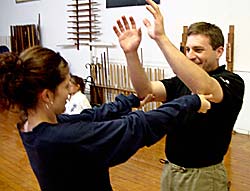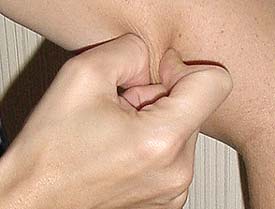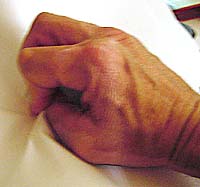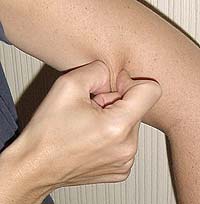Ouch!
The Mighty Little Pinch For Self-defense
By Christopher Caile
 Self-defense
isn't always against someone who is trying to hurt
you. Someone may grab you to control you, or maybe
is just fooling around. Self-defense
isn't always against someone who is trying to hurt
you. Someone may grab you to control you, or maybe
is just fooling around.
In these situations, and even against a real attacker,
one very effective self-defense technique is also
the simplest -- a little pinch. Pinches don't permanently
injure, but if done effectively -- wow, do they hurt.
All but the most determined attacker head for the
hills, or at least stop what they are doing and let
go.
I began teaching this technique as part of self-defense
when a student came to me a few years ago (at the
State University of New York at Buffalo where I used
to teach Seido karate) and asked what she could do
to stop her boyfriend from testing her self-defense
skills. He would playfully grab her in some hold,
like a bear hug, and say, "now what can you do
now?"
She didn't want to hurt him, so she didn't want attack
his groin, stomp a foot, or any number of other techniques
taught. Left with no tools she would just struggle.
As a result, she felt frustrated and her boyfriend
thought she wasn't learning anything useful.
I taught her the pinch. "Boy did that work!"
she reported back. "He tried a head lock. I just
pinched his leg once -- hard. He let go, jumped back
and yelled at me. But he hasn't tried anything since."
Just any pinch, however, won't do. You first have
to know the mechanics of a pinch and how to grab the
skin to make it most painful. You also have to know
which areas of the body are most sensitive. Put these
together and you have a real weapon.
Mechanics Of The Pinch

Most people pinch by catching skin between the tips
of two fingers. The pain produced, however, is reduced
by the fact that you are pressing two soft areas together
-- the tips of your fingers. Much more effective is
to catch skin between the tip of the first finger
and the hard surface of the second knuckle of the
thumb.
Even more effective, but more difficult to do, is
to use as a pinching mechanism the second knuckle
of both the thumb and the first finger -- two hard
surfaces pressed together.
The skin can be pinched between these two surfaces
or it can be rolled.
|
|
 |
|
Here the roll
and pinch is demonstrated on a sheet of paper.
|
Rolled is when, for example, a piece of skin is first
pinched between the hard surface of the thumb's first
knuckle and the inside of the first finger. As the
finger is pulled back toward the thumb's first knuckle,
the skin rolls up onto the top of the knuckle.
To get even more effect, once a pinch of skin is
firmly caught, you can roll the skin sideways between
your two finger surfaces. You can also twist both
fingers at the same time -- in an action like you
are trying to twist a knob.
Do all these together and you will maximize the pain.
You won't permanently injure someone, but often a
bruise appears where you have practiced this technique.
Don't try to catch a lot of skin. The less skin,
or thinner the fold of skin you catch, the more painful
it can be.
The Most Effective Targets
Your pinch will be most effective in areas where
the skin is naturally most sensitive. This includes:
• The inside and back
of the upper arms
• The sides of the upper
chest near the armpit and sides of the pectoral muscles.
• The area around a person's
nipples.
• The inside of either
leg from just above the knee all the way up to the
groin.
• The lob of the ear.
• The tip of the noise.
• The fold of skin between
the noise and the top lip.
• The male genitals.
 Practice
your pinches carefully. Experiment to see what is
most effective and where. Practice on yourself and
with a partner, so you can both learn and share the
pain and possibly the bruises the next day. Practice
your pinches carefully. Experiment to see what is
most effective and where. Practice on yourself and
with a partner, so you can both learn and share the
pain and possibly the bruises the next day.
Remember, however, that the pinch works best on people
with the most sensitive skin. Also, the effectiveness
of the pinch decreases with the intensity of the situation,
the presence of alcohol or other drugs and/or the
determination of the attacker. So, think of the pinch
as a useful tool that is helpful in a lot of situations,
especially when you are trying to discourage playful
fooling around attacks or against those who you do
not want to harm seriously.
About The Author:
Christopher Caile is the Founder and Editor-In-Chief
of FightingArts.com. He has been a student of the
martial arts for over 40 years and holds a 6th degree
black belt in Seido Karate and has experience in
judo, aikido, diato-ryu, boxing and several Chinese
fighting arts. He is also a long-term student of
one branch of Traditional Chinese Medicine, Qigong.
He is a personal disciple of the qi gong master
and teacher of acupuncture Dr. Zaiwan Shen (M.D.,
Ph.D.) and is Vice-President of the DS International
Chi Medicine Association. In Buffalo, NY, he founded
the Qi gong Healing Institute and The Qi Medicine
Association at the State University of New York
at Buffalo. He has also written on Qi gong and other
health topics in a national magazine, the Holistic
Health Journal and had been filmed for a prospective
PBS presentation on Alternative Medicine. Recently
he contributed a chapter on the subject to an award
winning book on alternative medicine, "Resources
Guide To Alternative Health" produced by
Health Inform.

back
to top
home
| about
us | magazine
| learning
| connections
| estore
|